 Employee Communication Best Practices
Employee Communication Best Practices
A cascading communication strategy has multiple advantages for large organizations. Here’s how to develop a successful plan that will boost efficiency and trust.

.webp)
Effective internal communication is the backbone of every successful organization. Learn the ins and outs of internal communications with our research-backed white paper.
Access NowEffective internal communication is the backbone of any successful organization. It ensures that employees at every level are aligned with the company's goals, culture, and operational priorities. When communication flows smoothly from leadership down to each department and individual, it fosters transparency, trust, and accountability, creating a cohesive work environment. In contrast, when information is unclear or inconsistently delivered, it can lead to confusion, misalignment, and decreased morale.
Given the ever-evolving nature of modern workplaces, organizations must prioritize communication strategies that engage and connect their employees at all levels. This is especially relevant with the rise of hybrid and remote work.
However, it can be an enormous challenge. While effective communication is a critical element for organizational success, many companies continue to face challenges in this area. According to Gallagher's State of the Sector 2023/24 report, organizations are struggling to adapt their communication strategies to meet the demands of growing teams and hybrid work environments. Ensuring employees feel engaged and informed remains a top priority, but many leaders still face significant hurdles in bridging gaps across diverse and dispersed workforces. At the same time, it shows that while “the same old organizational barriers persist,” Internal communicators are “becoming savvier about the business bottom line.”
Their survey findings revealed that a large percentage of respondents (72% of whom were from internal comms or HR) believe that employee engagement (74%) and strategy awareness (70%) are the most important success indicators of effective internal communication. However, about a third said disengaged employees presented a barrier of success in 2024. More than half (63%) said the major challenge was to engage teams on purpose, strategy, and values.
There are many channels of communications open to communicators. The challenge is to find which are most effective for your organization.
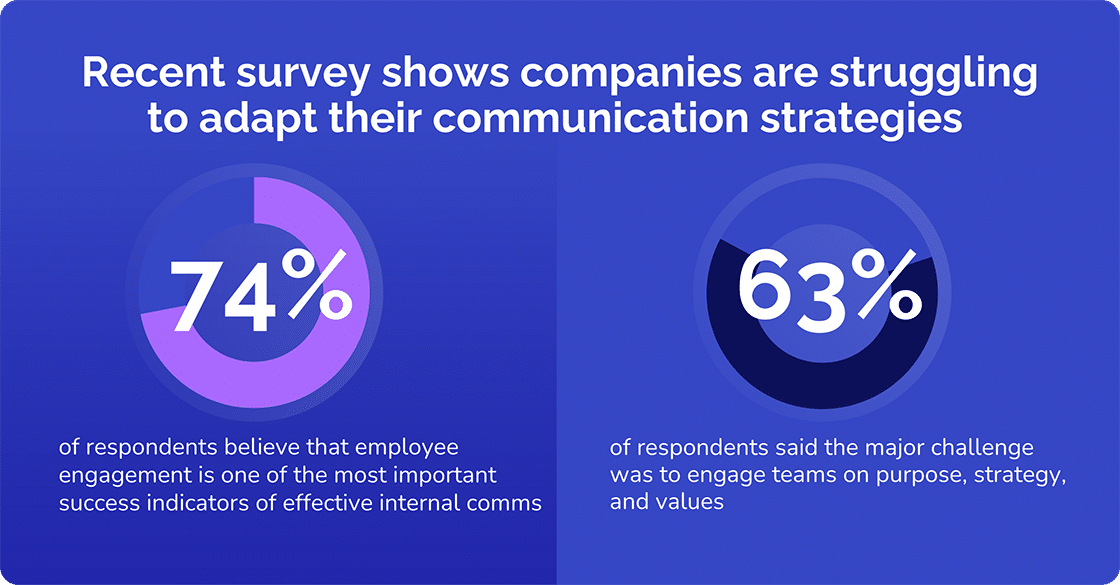
One of the most effective methods for ensuring consistent communication is through a cascading communication strategy. This is essentially a traditional top-down approach. But it goes a step further, ensuring that messages flow through the organization without altering the core message. Each leader tailors the communication to their team’s context while maintaining the original intent and keeping key directives intact.
Our seven-step approach will help you establish a strong internal communications framework.
Turn your internal communications strategy around today

A cascading strategy allows information to flow systematically from top-level executives to middle management, and then to frontline employees. Each level of leadership is responsible for relaying the message to the next. The aim is to make sure it is tailored appropriately for its audience without altering the core message. This process not only ensures consistency but also allows for better employee engagement. Ultimately, managers can address the unique concerns and contexts of their teams while delivering the overarching organizational message.
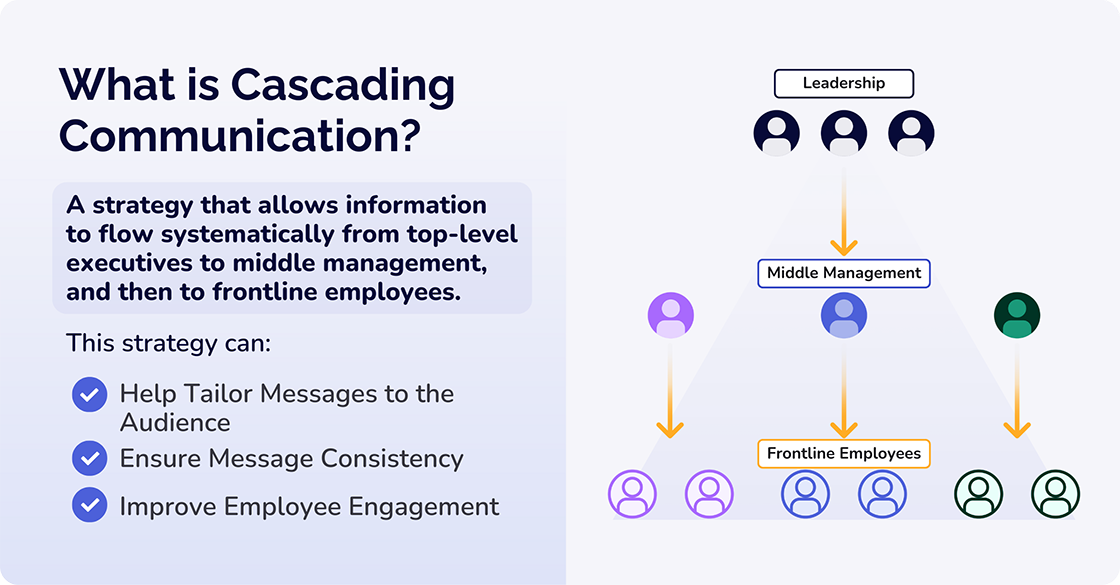
It is worth noting that Gallup's 2023 State of the Global Workplace report emphasizes that employee engagement is significantly influenced by leadership and management. It highlights that employees who trust their managers are more likely to be engaged in their roles. This underscores the crucial role of managers in cascading internal communications and maintaining employee trust.
Research by Edelman shows that employees are more likely to trust messages coming from their direct peers and managers than from upper leadership. His Trust Barometer is a well-known annual study. It explores global trust levels in institutions, including businesses, government, media, and NGOs. The suggestion is that communication from direct leaders can have a greater impact on employee engagement than messages that solely come from the upper echelons of the organization.
This insight has driven organizations to reconsider how they cascade communications. The pivotal aim is to ensure that mid-level leaders are empowered to communicate effectively and authentically to their teams. Edelman's data also indicates that trust in peers is critical for fostering a positive work culture.
Ultimately, a well-structured cascading communication strategy not only improves the accuracy and consistency of internal messaging but also reinforces trust across the organization. When done effectively, it can be a powerful tool in enhancing employee alignment and boosting overall organizational efficiency.
Nothing is perfect, and potential pitfalls include message dilution or inconsistency as information moves through layers of management. When you cascade communications, there is also the risk of misinterpretation. This is because messages pass through multiple levels of leadership, where each manager may have a different communication style. This can lead to varied interpretations, especially if instructions are not clear and concise. Additionally, the further down the communication flows, the more likely it is for employees to feel disconnected from the original message, reducing its impact.
In a Poppulo post, Cascading Leadership Communications: Getting it Right Without the Pitfalls, communication and engagement consultant, Joanna Hall, highlights the challenges. She warns that it “isn’t as easy as merely passing on a message to the influencers within your business and expecting it to land well, job done.” It is vital for leaders to leverage and manage the cascade channel well.
To combat these challenges, organizations must focus on training leaders and managers to become more effective communicators. They must also emphasize empathy and adaptability. It is also crucial for organizations to provide standardized communication tools and frameworks. Communication leaders need to ensure that everyone at every level has the support needed to deliver the message accurately. It must also be delivered in a timely manner.
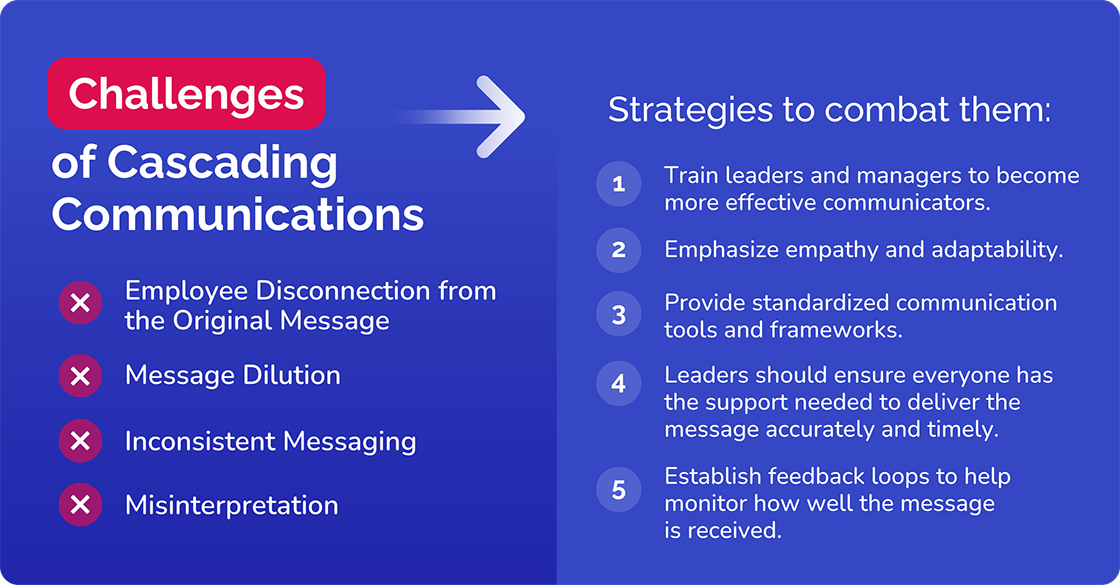
Moreover, establishing feedback loops can help monitor how well the message is received and understood, providing an opportunity for clarification and adjustment where needed.
Hall makes another important point. “While cascading communication through influential channels has its benefits, it should not replace top-down communication entirely.”
Turn your internal communications strategy around today

Setting up an effective cascading communication strategy generally involves at least seven key steps.
Clearly outline the key information or strategic directive that needs to be communicated, ensuring it aligns with organizational goals. The core message should be concise and actionable, with clear outcomes expected from employees at all levels.
The outcomes expected from employees at all levels must help to ensure that employees understand the message fully. Additionally, they must know exactly what is expected of them and how their efforts contribute to the organization’s success. For example, there must be a clear understanding of how the message relates to the company's broader strategy and its role in achieving it.
There should also be measurable targets or objectives that employees can work toward, specifying deadlines or key milestones.
Determine the layers of leadership and influencers responsible for passing the message down to the next level. It’s important to select leaders who have a strong influence within their teams. They will be key in ensuring the message is properly understood and conveyed.
Begin by mapping out an organizational structure. Then, identify key decision-makers and influencers at each level who can effectively relay messages. Not all managers are equally effective communicators. It is also important to identify leaders across departments who regularly collaborate. They can help bridge potential communication gaps between teams. Additionally, they can ensure the message is aligned throughout different areas of the business.
Customize communications to suit each level of the organization. Different teams may require specific examples or adjustments to help them relate to the message. For this reason, it is vital to ensure that while the core message remains consistent, the delivery speaks to the concerns of each specific audience.
Equip managers with the skills and resources needed to communicate effectively. This includes not only the message itself but also how to answer questions, clarify concerns, and engage their teams in productive discussions. By emphasizing direct communication, managers can create stronger connections and ensure that the core message is fully understood at every level of the organization.
Identify the best direct communication channels for each level of the organization, whether it's email, in-person meetings, virtual platforms, or internal messaging systems. Consider the preferences and access levels of different employees to ensure the message is delivered in a format they are most likely to engage with. Using a mix of channels ensures that the message is not only delivered but also understood and retained by all employees.
For example, you can use emails to distribute newsletters, intranet for formal updates, team meetings for discussions, and town halls for leaders to communicate directly with employees.
Jennifer L. Pakradooni, Head of External Communications at Newmont Corporation, talks about How cascading information can lead to a more engaged workforce. Acknowledging that some employees may prefer or respond better to other communication channels, she says she’s seen engagement, related to employees understanding a company’s strategy and their CEO’s defined priorities, increase by 18%.
“When leaders cascade information well, it can also lead to increased motivation, engagement, and trust across an organization. As a best practice, it is important a CEO has identified communications channels as well as defined processes that can help streamline the messages they want to deliver. Next it’s critical their leadership team cascades that message in a unified way across the organization.” Jennifer L. Pakradooni
Ensure there are ways to track how well the message is understood at each level. Feedback loops, such as surveys, one-on-one check-ins, or team discussions, allow employees to voice concerns, ask questions, and offer suggestions, helping to identify any gaps in understanding.
“Cascading communication through influential channels encourages a more open and interactive dialogue. Employees often feel more comfortable expressing their questions, concerns, and feedback to the people they know and trust most. Your influencers will likely act as intermediaries, creating a feedback loop that can be advantageous for internal communicators and employees alike.” Joanna Hall
Regularly check in on the progress of the communication to ensure consistency and alignment across teams. Reinforce the message with follow-ups and updates to keep it top of mind and ensure that any misunderstandings are addressed before they become larger issues.
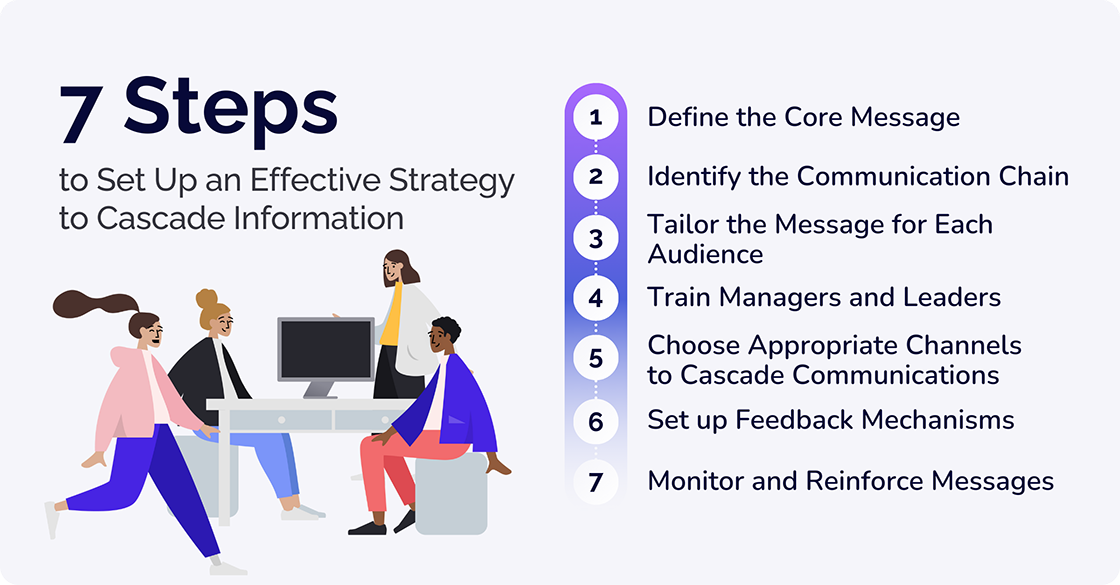
Cerkl Broadcast offers a powerful platform that enables internal communicators to streamline the implementation of any internal communications strategy. It provides a centralized communication hub that enables communicators to easily access and manage information, making planning and implementation considerably more effective.
Broadcast also offers great content scheduling features. For example, whichever channels they use, communicators can strategically plan the timing and frequency of messages to reach their audience at the most opportune moments. Audience Manager simplifies employee segmentation, while Email Blasts save time and effort.
Broadcast's feedback and analytics tools allow communicators to measure message impact. This enhances the planning process with data-driven insights that enable you to effectively adapt and constantly improve cascading strategies.
Whether or not you are planning to implement a cascading communications strategy, it’s crucial to assess your existing internal communications plan. Our white paper, Importance of Internal Communication, is packed with guidelines and information to help you. And the good news is that we’re offering this invaluable resource to you free of charge.
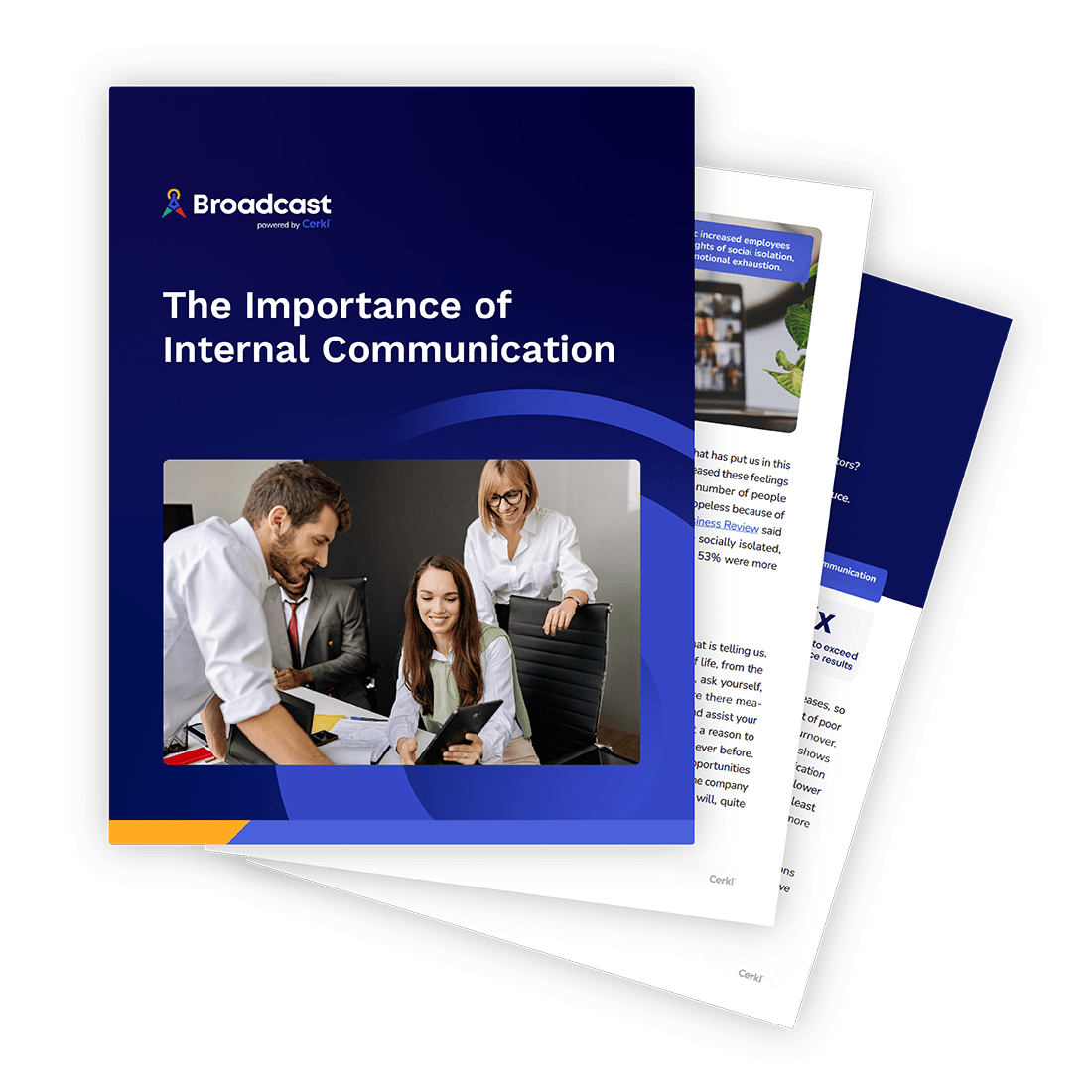
Turn your internal communications strategy around today
What is a cascading message? A cascading message refers to information that is communicated from upper management to lower levels in an organization through a structured, step-by-step process. It starts at the top and flows through various levels, ensuring consistency and alignment across the organization.
How do you cascade information effectively? To cascade information effectively, ensure that messages are clear, concise, and tailored to each audience, and provide managers with the tools and training needed to communicate internal communications effectively. Regular follow-up and feedback loops help ensure the message is understood and acted upon consistently.
What is an example of a cascade interaction? An example of a cascade interaction is when a CEO communicates a strategic change to senior managers, who then explain the changes to their department heads, and the department heads further discuss the details with their teams. Each level adapts the message to its specific context while maintaining the core directive.

Turn your internal communications strategy around today